Advanced Financial Accounting: Framework, Regulations, and Valuation
VerifiedAdded on 2021/05/30
|11
|2777
|29
Report
AI Summary
This report provides a comprehensive overview of advanced financial accounting, focusing on the conceptual framework, qualitative characteristics, and the role of financial reporting. It explores the primary users of financial reporting and the significance of relevance and faithfulness. The report delves into various theories of regulation, including public interest theory, capture theory, and economic interest group theory, analyzing their impact on corporate social responsibility. It also examines the differences between GAAP and IFRS concerning noncurrent asset valuation, asset impairment, and the presentation of discontinued operations. The report further investigates the motivations behind asset revaluation practices, their effects on financial statements, and the importance of accurate valuation models. Finally, it highlights the effects of not adopting revaluation on key financial metrics and the impact of revaluation on shareholder's equity and net income.
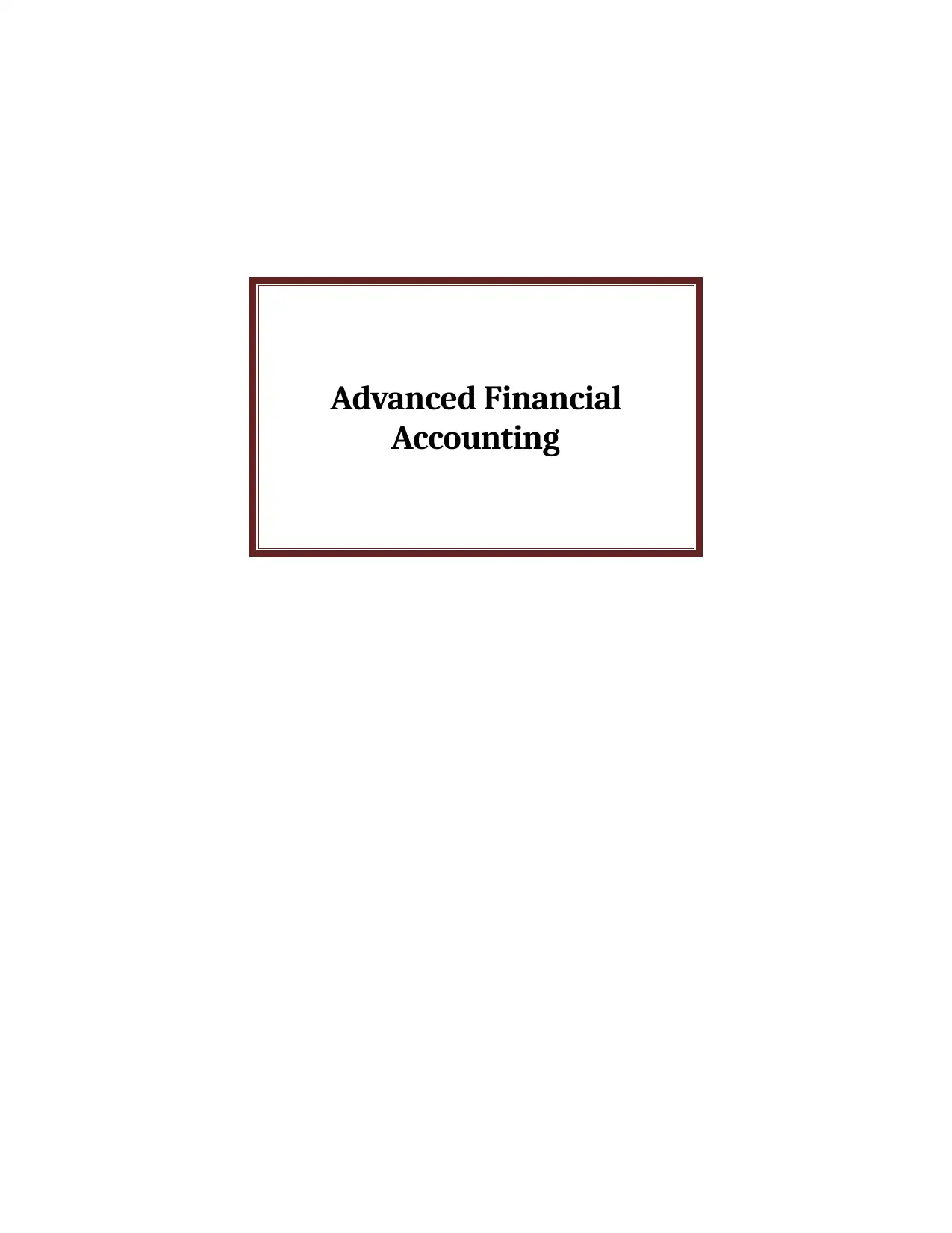
Advanced Financial
Accounting
Accounting
Paraphrase This Document
Need a fresh take? Get an instant paraphrase of this document with our AI Paraphraser
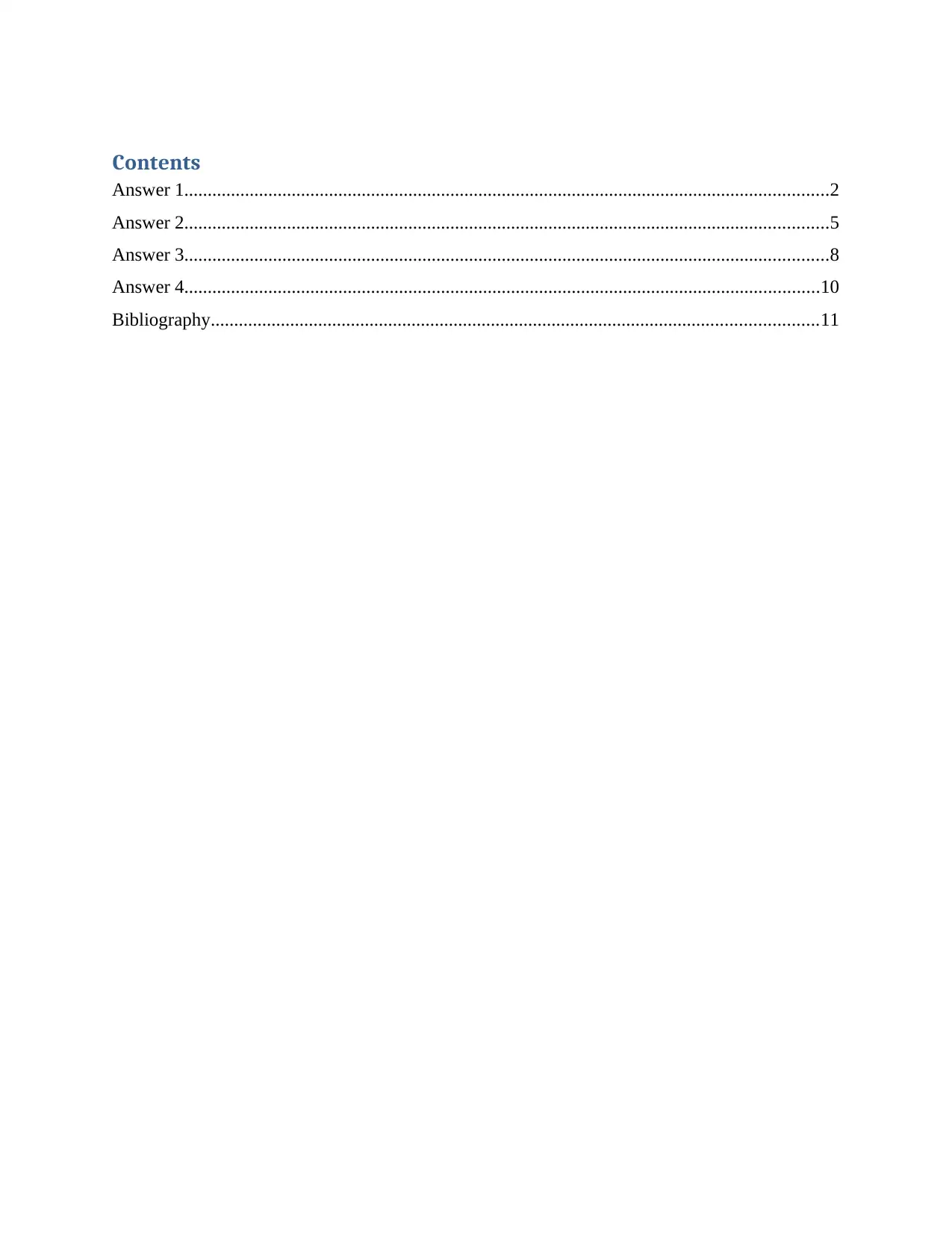
Contents
Answer 1..........................................................................................................................................2
Answer 2..........................................................................................................................................5
Answer 3..........................................................................................................................................8
Answer 4........................................................................................................................................10
Bibliography..................................................................................................................................11
Answer 1..........................................................................................................................................2
Answer 2..........................................................................................................................................5
Answer 3..........................................................................................................................................8
Answer 4........................................................................................................................................10
Bibliography..................................................................................................................................11
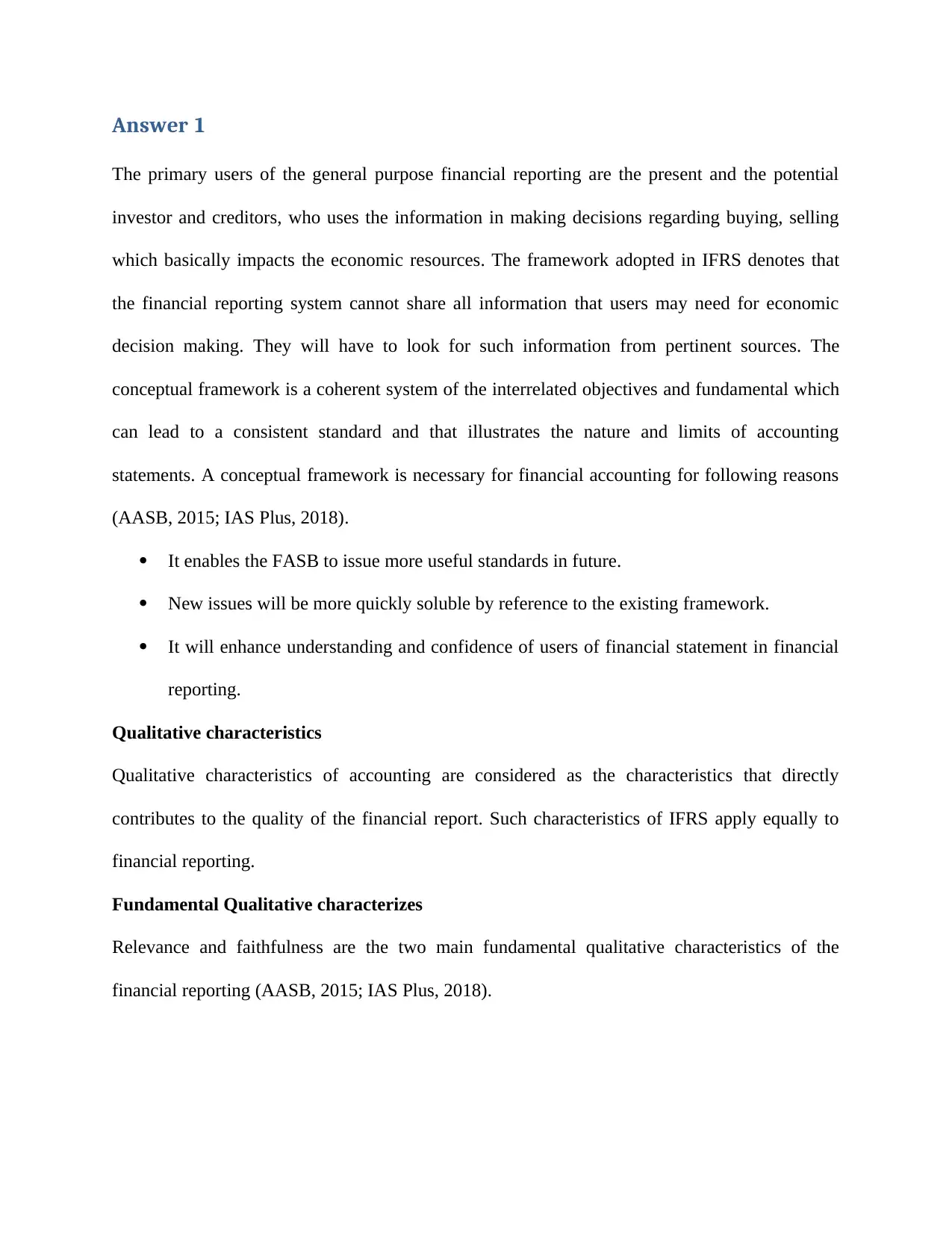
Answer 1
The primary users of the general purpose financial reporting are the present and the potential
investor and creditors, who uses the information in making decisions regarding buying, selling
which basically impacts the economic resources. The framework adopted in IFRS denotes that
the financial reporting system cannot share all information that users may need for economic
decision making. They will have to look for such information from pertinent sources. The
conceptual framework is a coherent system of the interrelated objectives and fundamental which
can lead to a consistent standard and that illustrates the nature and limits of accounting
statements. A conceptual framework is necessary for financial accounting for following reasons
(AASB, 2015; IAS Plus, 2018).
It enables the FASB to issue more useful standards in future.
New issues will be more quickly soluble by reference to the existing framework.
It will enhance understanding and confidence of users of financial statement in financial
reporting.
Qualitative characteristics
Qualitative characteristics of accounting are considered as the characteristics that directly
contributes to the quality of the financial report. Such characteristics of IFRS apply equally to
financial reporting.
Fundamental Qualitative characterizes
Relevance and faithfulness are the two main fundamental qualitative characteristics of the
financial reporting (AASB, 2015; IAS Plus, 2018).
The primary users of the general purpose financial reporting are the present and the potential
investor and creditors, who uses the information in making decisions regarding buying, selling
which basically impacts the economic resources. The framework adopted in IFRS denotes that
the financial reporting system cannot share all information that users may need for economic
decision making. They will have to look for such information from pertinent sources. The
conceptual framework is a coherent system of the interrelated objectives and fundamental which
can lead to a consistent standard and that illustrates the nature and limits of accounting
statements. A conceptual framework is necessary for financial accounting for following reasons
(AASB, 2015; IAS Plus, 2018).
It enables the FASB to issue more useful standards in future.
New issues will be more quickly soluble by reference to the existing framework.
It will enhance understanding and confidence of users of financial statement in financial
reporting.
Qualitative characteristics
Qualitative characteristics of accounting are considered as the characteristics that directly
contributes to the quality of the financial report. Such characteristics of IFRS apply equally to
financial reporting.
Fundamental Qualitative characterizes
Relevance and faithfulness are the two main fundamental qualitative characteristics of the
financial reporting (AASB, 2015; IAS Plus, 2018).
⊘ This is a preview!⊘
Do you want full access?
Subscribe today to unlock all pages.

Trusted by 1+ million students worldwide
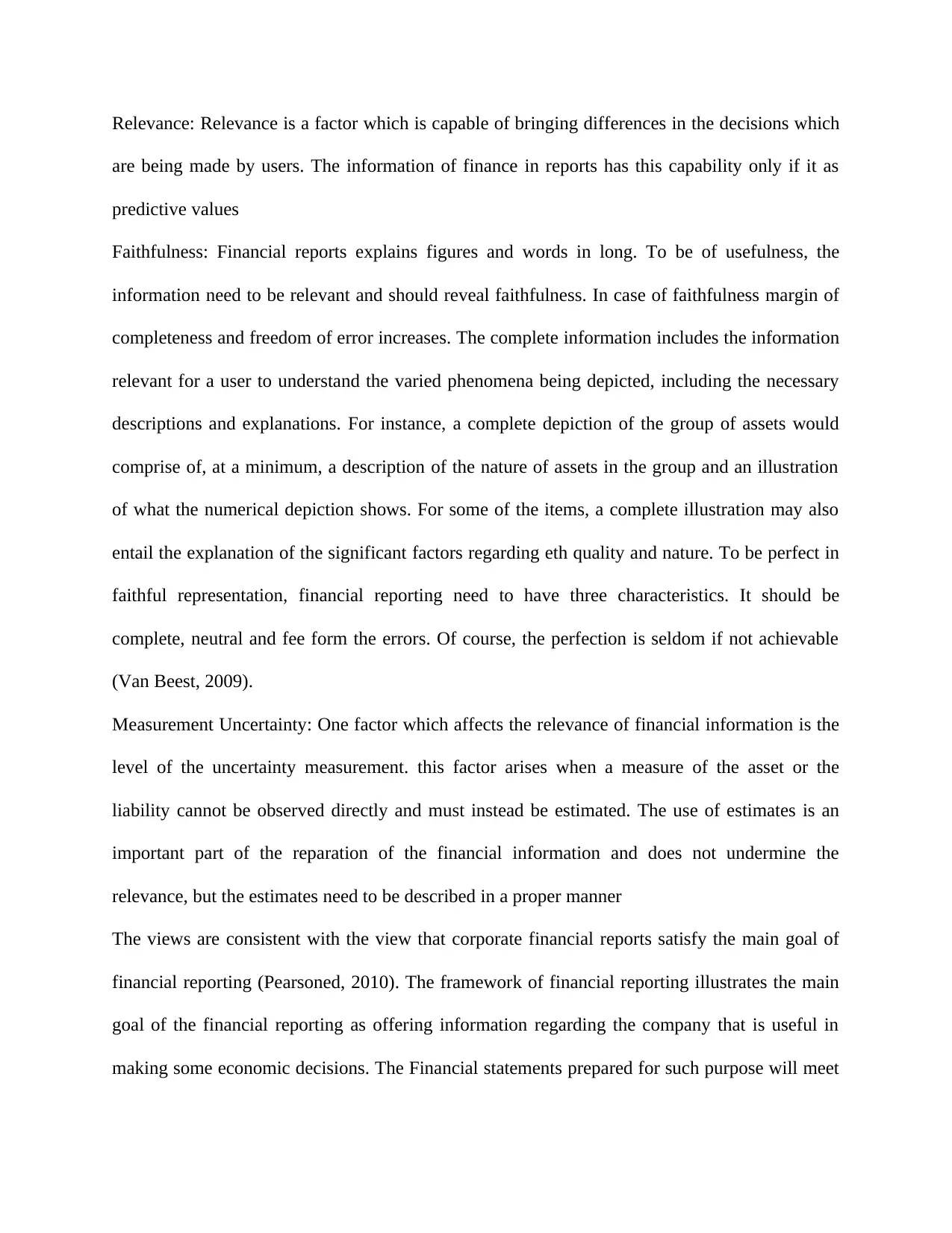
Relevance: Relevance is a factor which is capable of bringing differences in the decisions which
are being made by users. The information of finance in reports has this capability only if it as
predictive values
Faithfulness: Financial reports explains figures and words in long. To be of usefulness, the
information need to be relevant and should reveal faithfulness. In case of faithfulness margin of
completeness and freedom of error increases. The complete information includes the information
relevant for a user to understand the varied phenomena being depicted, including the necessary
descriptions and explanations. For instance, a complete depiction of the group of assets would
comprise of, at a minimum, a description of the nature of assets in the group and an illustration
of what the numerical depiction shows. For some of the items, a complete illustration may also
entail the explanation of the significant factors regarding eth quality and nature. To be perfect in
faithful representation, financial reporting need to have three characteristics. It should be
complete, neutral and fee form the errors. Of course, the perfection is seldom if not achievable
(Van Beest, 2009).
Measurement Uncertainty: One factor which affects the relevance of financial information is the
level of the uncertainty measurement. this factor arises when a measure of the asset or the
liability cannot be observed directly and must instead be estimated. The use of estimates is an
important part of the reparation of the financial information and does not undermine the
relevance, but the estimates need to be described in a proper manner
The views are consistent with the view that corporate financial reports satisfy the main goal of
financial reporting (Pearsoned, 2010). The framework of financial reporting illustrates the main
goal of the financial reporting as offering information regarding the company that is useful in
making some economic decisions. The Financial statements prepared for such purpose will meet
are being made by users. The information of finance in reports has this capability only if it as
predictive values
Faithfulness: Financial reports explains figures and words in long. To be of usefulness, the
information need to be relevant and should reveal faithfulness. In case of faithfulness margin of
completeness and freedom of error increases. The complete information includes the information
relevant for a user to understand the varied phenomena being depicted, including the necessary
descriptions and explanations. For instance, a complete depiction of the group of assets would
comprise of, at a minimum, a description of the nature of assets in the group and an illustration
of what the numerical depiction shows. For some of the items, a complete illustration may also
entail the explanation of the significant factors regarding eth quality and nature. To be perfect in
faithful representation, financial reporting need to have three characteristics. It should be
complete, neutral and fee form the errors. Of course, the perfection is seldom if not achievable
(Van Beest, 2009).
Measurement Uncertainty: One factor which affects the relevance of financial information is the
level of the uncertainty measurement. this factor arises when a measure of the asset or the
liability cannot be observed directly and must instead be estimated. The use of estimates is an
important part of the reparation of the financial information and does not undermine the
relevance, but the estimates need to be described in a proper manner
The views are consistent with the view that corporate financial reports satisfy the main goal of
financial reporting (Pearsoned, 2010). The framework of financial reporting illustrates the main
goal of the financial reporting as offering information regarding the company that is useful in
making some economic decisions. The Financial statements prepared for such purpose will meet
Paraphrase This Document
Need a fresh take? Get an instant paraphrase of this document with our AI Paraphraser
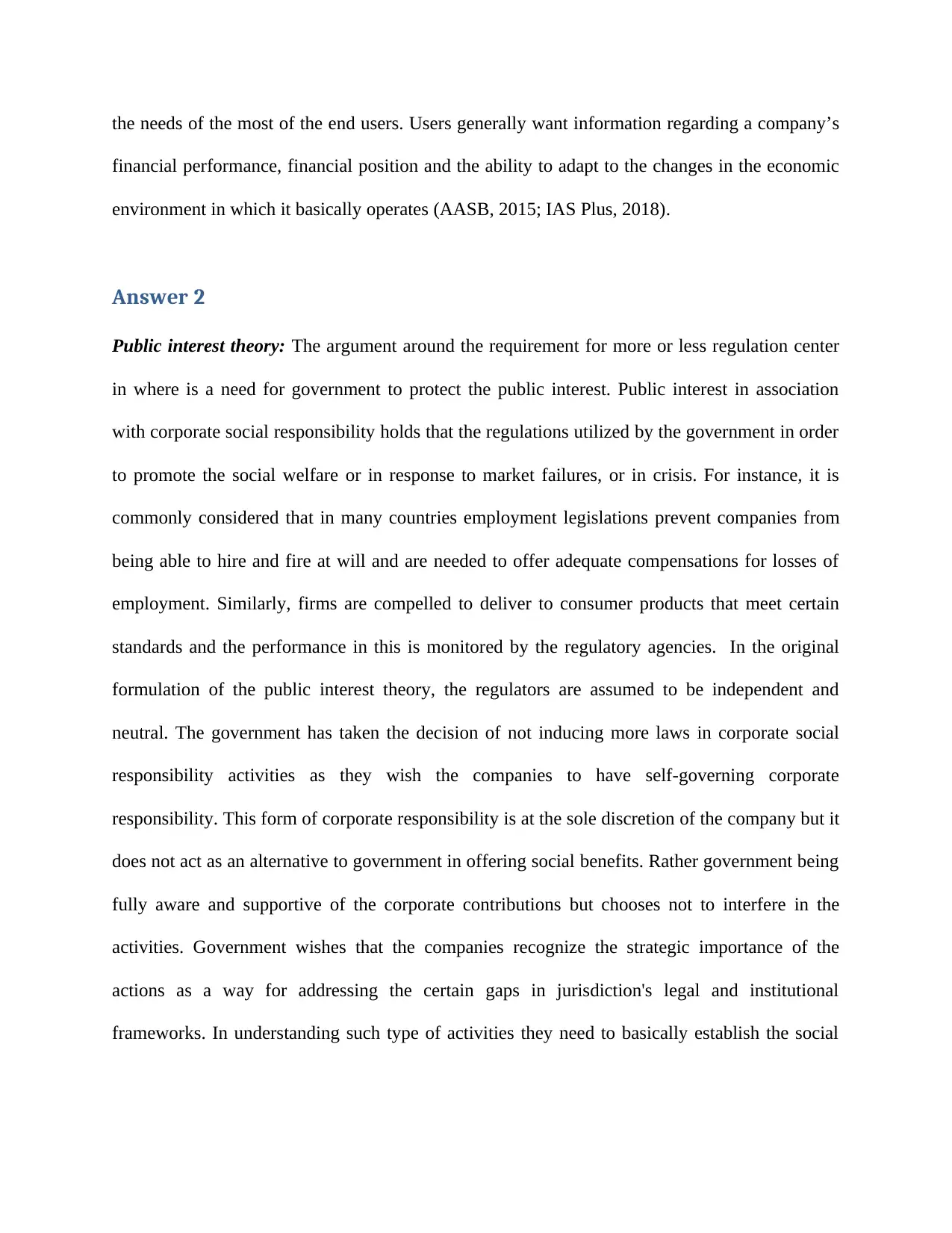
the needs of the most of the end users. Users generally want information regarding a company’s
financial performance, financial position and the ability to adapt to the changes in the economic
environment in which it basically operates (AASB, 2015; IAS Plus, 2018).
Answer 2
Public interest theory: The argument around the requirement for more or less regulation center
in where is a need for government to protect the public interest. Public interest in association
with corporate social responsibility holds that the regulations utilized by the government in order
to promote the social welfare or in response to market failures, or in crisis. For instance, it is
commonly considered that in many countries employment legislations prevent companies from
being able to hire and fire at will and are needed to offer adequate compensations for losses of
employment. Similarly, firms are compelled to deliver to consumer products that meet certain
standards and the performance in this is monitored by the regulatory agencies. In the original
formulation of the public interest theory, the regulators are assumed to be independent and
neutral. The government has taken the decision of not inducing more laws in corporate social
responsibility activities as they wish the companies to have self-governing corporate
responsibility. This form of corporate responsibility is at the sole discretion of the company but it
does not act as an alternative to government in offering social benefits. Rather government being
fully aware and supportive of the corporate contributions but chooses not to interfere in the
activities. Government wishes that the companies recognize the strategic importance of the
actions as a way for addressing the certain gaps in jurisdiction's legal and institutional
frameworks. In understanding such type of activities they need to basically establish the social
financial performance, financial position and the ability to adapt to the changes in the economic
environment in which it basically operates (AASB, 2015; IAS Plus, 2018).
Answer 2
Public interest theory: The argument around the requirement for more or less regulation center
in where is a need for government to protect the public interest. Public interest in association
with corporate social responsibility holds that the regulations utilized by the government in order
to promote the social welfare or in response to market failures, or in crisis. For instance, it is
commonly considered that in many countries employment legislations prevent companies from
being able to hire and fire at will and are needed to offer adequate compensations for losses of
employment. Similarly, firms are compelled to deliver to consumer products that meet certain
standards and the performance in this is monitored by the regulatory agencies. In the original
formulation of the public interest theory, the regulators are assumed to be independent and
neutral. The government has taken the decision of not inducing more laws in corporate social
responsibility activities as they wish the companies to have self-governing corporate
responsibility. This form of corporate responsibility is at the sole discretion of the company but it
does not act as an alternative to government in offering social benefits. Rather government being
fully aware and supportive of the corporate contributions but chooses not to interfere in the
activities. Government wishes that the companies recognize the strategic importance of the
actions as a way for addressing the certain gaps in jurisdiction's legal and institutional
frameworks. In understanding such type of activities they need to basically establish the social
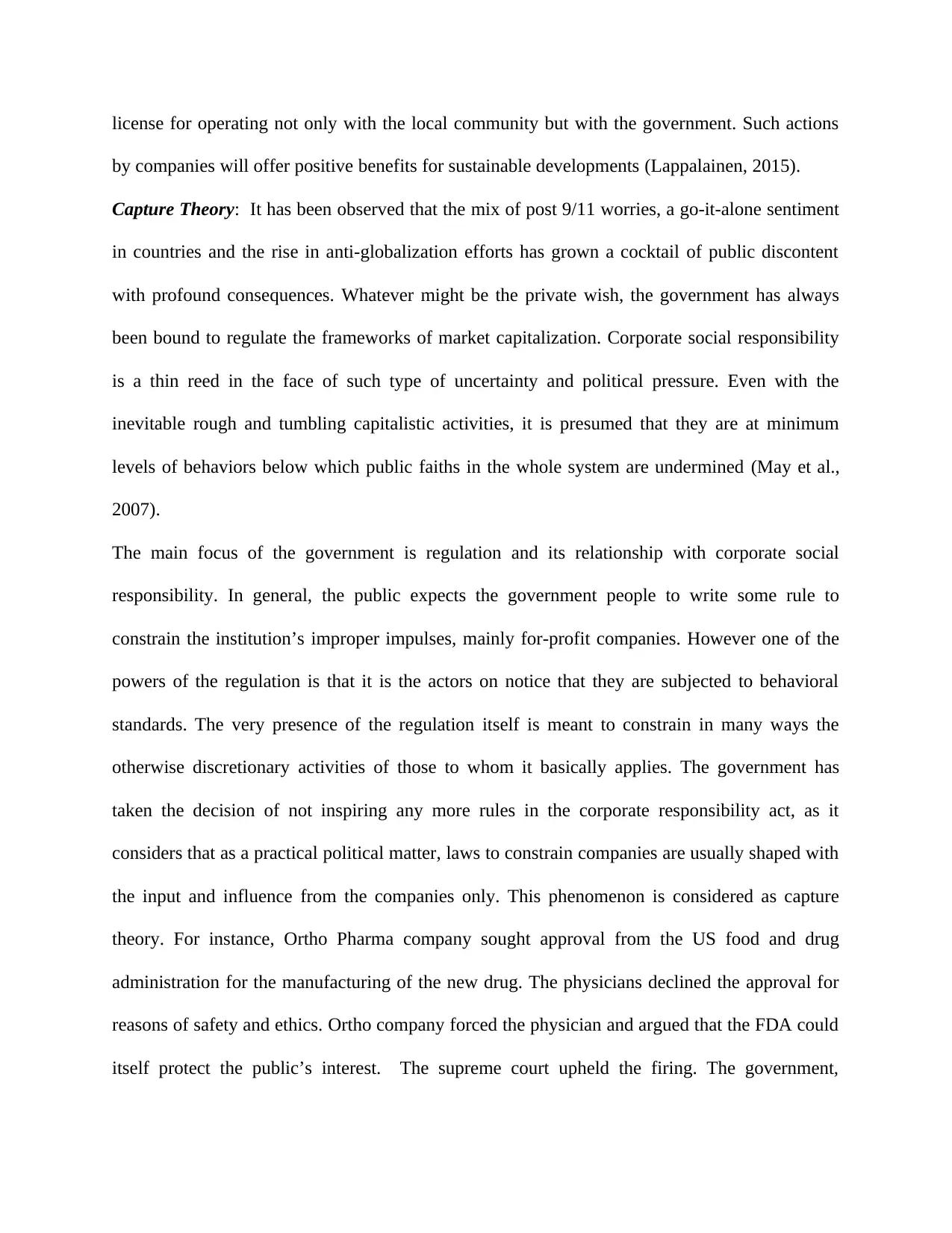
license for operating not only with the local community but with the government. Such actions
by companies will offer positive benefits for sustainable developments (Lappalainen, 2015).
Capture Theory: It has been observed that the mix of post 9/11 worries, a go-it-alone sentiment
in countries and the rise in anti-globalization efforts has grown a cocktail of public discontent
with profound consequences. Whatever might be the private wish, the government has always
been bound to regulate the frameworks of market capitalization. Corporate social responsibility
is a thin reed in the face of such type of uncertainty and political pressure. Even with the
inevitable rough and tumbling capitalistic activities, it is presumed that they are at minimum
levels of behaviors below which public faiths in the whole system are undermined (May et al.,
2007).
The main focus of the government is regulation and its relationship with corporate social
responsibility. In general, the public expects the government people to write some rule to
constrain the institution’s improper impulses, mainly for-profit companies. However one of the
powers of the regulation is that it is the actors on notice that they are subjected to behavioral
standards. The very presence of the regulation itself is meant to constrain in many ways the
otherwise discretionary activities of those to whom it basically applies. The government has
taken the decision of not inspiring any more rules in the corporate responsibility act, as it
considers that as a practical political matter, laws to constrain companies are usually shaped with
the input and influence from the companies only. This phenomenon is considered as capture
theory. For instance, Ortho Pharma company sought approval from the US food and drug
administration for the manufacturing of the new drug. The physicians declined the approval for
reasons of safety and ethics. Ortho company forced the physician and argued that the FDA could
itself protect the public’s interest. The supreme court upheld the firing. The government,
by companies will offer positive benefits for sustainable developments (Lappalainen, 2015).
Capture Theory: It has been observed that the mix of post 9/11 worries, a go-it-alone sentiment
in countries and the rise in anti-globalization efforts has grown a cocktail of public discontent
with profound consequences. Whatever might be the private wish, the government has always
been bound to regulate the frameworks of market capitalization. Corporate social responsibility
is a thin reed in the face of such type of uncertainty and political pressure. Even with the
inevitable rough and tumbling capitalistic activities, it is presumed that they are at minimum
levels of behaviors below which public faiths in the whole system are undermined (May et al.,
2007).
The main focus of the government is regulation and its relationship with corporate social
responsibility. In general, the public expects the government people to write some rule to
constrain the institution’s improper impulses, mainly for-profit companies. However one of the
powers of the regulation is that it is the actors on notice that they are subjected to behavioral
standards. The very presence of the regulation itself is meant to constrain in many ways the
otherwise discretionary activities of those to whom it basically applies. The government has
taken the decision of not inspiring any more rules in the corporate responsibility act, as it
considers that as a practical political matter, laws to constrain companies are usually shaped with
the input and influence from the companies only. This phenomenon is considered as capture
theory. For instance, Ortho Pharma company sought approval from the US food and drug
administration for the manufacturing of the new drug. The physicians declined the approval for
reasons of safety and ethics. Ortho company forced the physician and argued that the FDA could
itself protect the public’s interest. The supreme court upheld the firing. The government,
⊘ This is a preview!⊘
Do you want full access?
Subscribe today to unlock all pages.

Trusted by 1+ million students worldwide
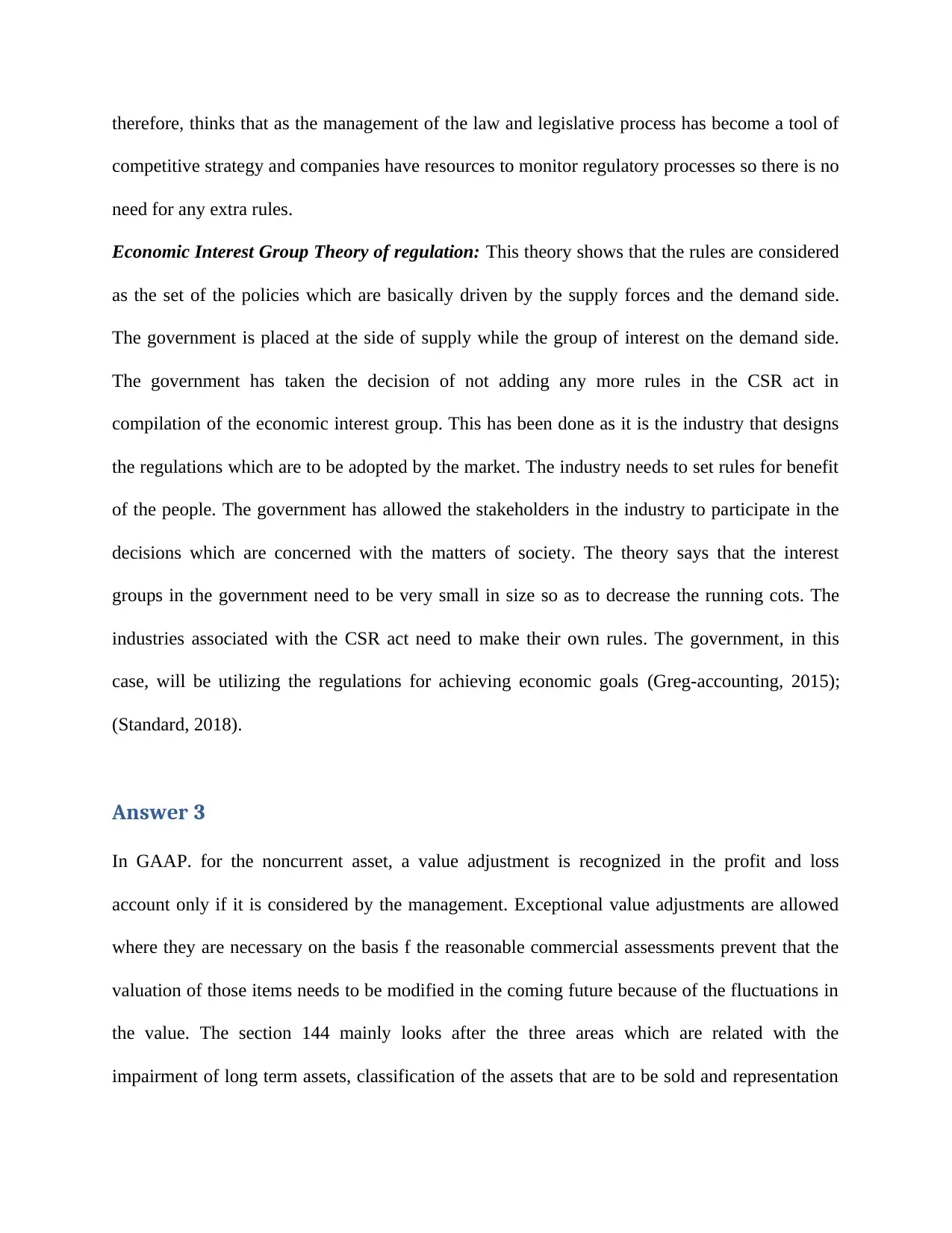
therefore, thinks that as the management of the law and legislative process has become a tool of
competitive strategy and companies have resources to monitor regulatory processes so there is no
need for any extra rules.
Economic Interest Group Theory of regulation: This theory shows that the rules are considered
as the set of the policies which are basically driven by the supply forces and the demand side.
The government is placed at the side of supply while the group of interest on the demand side.
The government has taken the decision of not adding any more rules in the CSR act in
compilation of the economic interest group. This has been done as it is the industry that designs
the regulations which are to be adopted by the market. The industry needs to set rules for benefit
of the people. The government has allowed the stakeholders in the industry to participate in the
decisions which are concerned with the matters of society. The theory says that the interest
groups in the government need to be very small in size so as to decrease the running cots. The
industries associated with the CSR act need to make their own rules. The government, in this
case, will be utilizing the regulations for achieving economic goals (Greg-accounting, 2015);
(Standard, 2018).
Answer 3
In GAAP. for the noncurrent asset, a value adjustment is recognized in the profit and loss
account only if it is considered by the management. Exceptional value adjustments are allowed
where they are necessary on the basis f the reasonable commercial assessments prevent that the
valuation of those items needs to be modified in the coming future because of the fluctuations in
the value. The section 144 mainly looks after the three areas which are related with the
impairment of long term assets, classification of the assets that are to be sold and representation
competitive strategy and companies have resources to monitor regulatory processes so there is no
need for any extra rules.
Economic Interest Group Theory of regulation: This theory shows that the rules are considered
as the set of the policies which are basically driven by the supply forces and the demand side.
The government is placed at the side of supply while the group of interest on the demand side.
The government has taken the decision of not adding any more rules in the CSR act in
compilation of the economic interest group. This has been done as it is the industry that designs
the regulations which are to be adopted by the market. The industry needs to set rules for benefit
of the people. The government has allowed the stakeholders in the industry to participate in the
decisions which are concerned with the matters of society. The theory says that the interest
groups in the government need to be very small in size so as to decrease the running cots. The
industries associated with the CSR act need to make their own rules. The government, in this
case, will be utilizing the regulations for achieving economic goals (Greg-accounting, 2015);
(Standard, 2018).
Answer 3
In GAAP. for the noncurrent asset, a value adjustment is recognized in the profit and loss
account only if it is considered by the management. Exceptional value adjustments are allowed
where they are necessary on the basis f the reasonable commercial assessments prevent that the
valuation of those items needs to be modified in the coming future because of the fluctuations in
the value. The section 144 mainly looks after the three areas which are related with the
impairment of long term assets, classification of the assets that are to be sold and representation
Paraphrase This Document
Need a fresh take? Get an instant paraphrase of this document with our AI Paraphraser
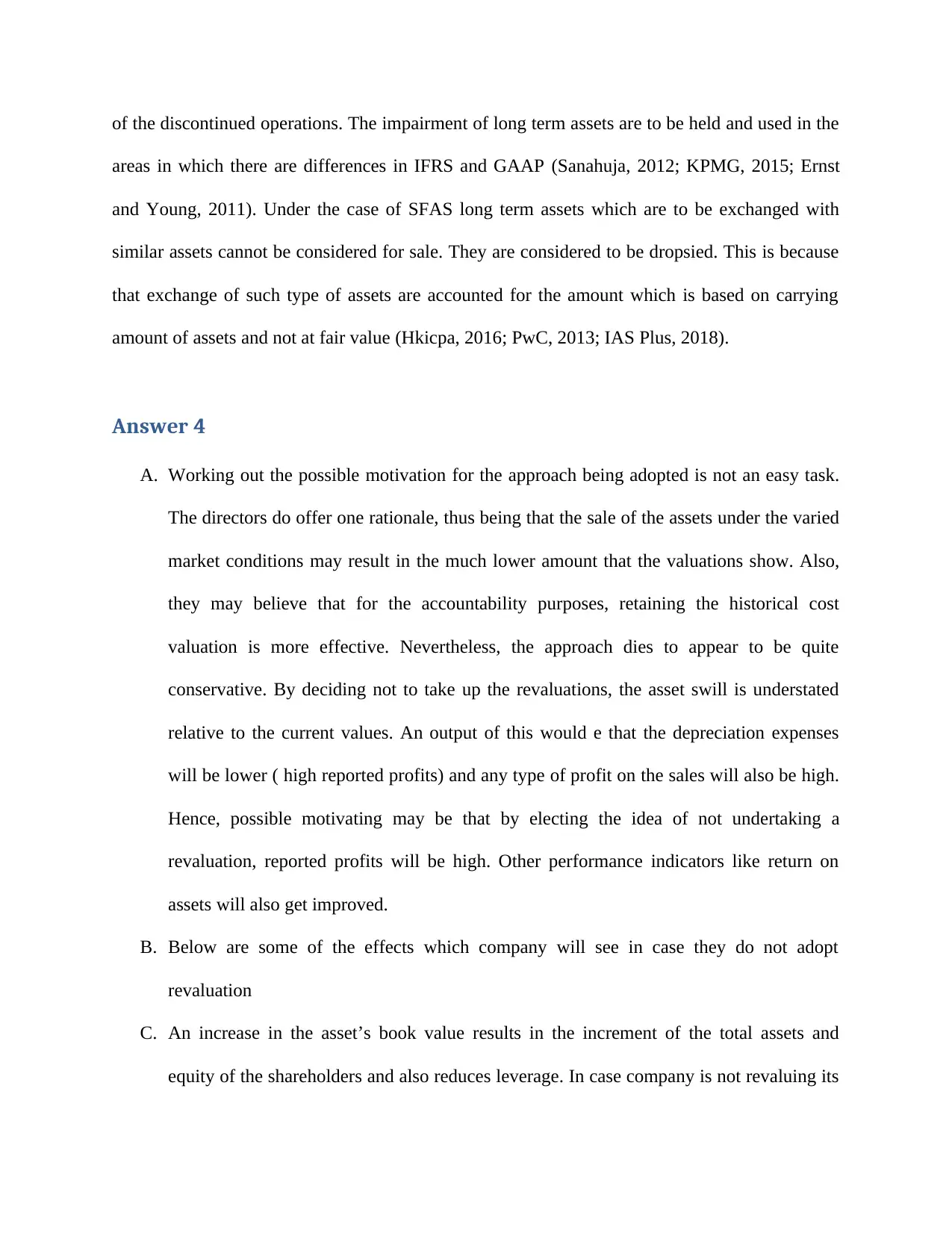
of the discontinued operations. The impairment of long term assets are to be held and used in the
areas in which there are differences in IFRS and GAAP (Sanahuja, 2012; KPMG, 2015; Ernst
and Young, 2011). Under the case of SFAS long term assets which are to be exchanged with
similar assets cannot be considered for sale. They are considered to be dropsied. This is because
that exchange of such type of assets are accounted for the amount which is based on carrying
amount of assets and not at fair value (Hkicpa, 2016; PwC, 2013; IAS Plus, 2018).
Answer 4
A. Working out the possible motivation for the approach being adopted is not an easy task.
The directors do offer one rationale, thus being that the sale of the assets under the varied
market conditions may result in the much lower amount that the valuations show. Also,
they may believe that for the accountability purposes, retaining the historical cost
valuation is more effective. Nevertheless, the approach dies to appear to be quite
conservative. By deciding not to take up the revaluations, the asset swill is understated
relative to the current values. An output of this would e that the depreciation expenses
will be lower ( high reported profits) and any type of profit on the sales will also be high.
Hence, possible motivating may be that by electing the idea of not undertaking a
revaluation, reported profits will be high. Other performance indicators like return on
assets will also get improved.
B. Below are some of the effects which company will see in case they do not adopt
revaluation
C. An increase in the asset’s book value results in the increment of the total assets and
equity of the shareholders and also reduces leverage. In case company is not revaluing its
areas in which there are differences in IFRS and GAAP (Sanahuja, 2012; KPMG, 2015; Ernst
and Young, 2011). Under the case of SFAS long term assets which are to be exchanged with
similar assets cannot be considered for sale. They are considered to be dropsied. This is because
that exchange of such type of assets are accounted for the amount which is based on carrying
amount of assets and not at fair value (Hkicpa, 2016; PwC, 2013; IAS Plus, 2018).
Answer 4
A. Working out the possible motivation for the approach being adopted is not an easy task.
The directors do offer one rationale, thus being that the sale of the assets under the varied
market conditions may result in the much lower amount that the valuations show. Also,
they may believe that for the accountability purposes, retaining the historical cost
valuation is more effective. Nevertheless, the approach dies to appear to be quite
conservative. By deciding not to take up the revaluations, the asset swill is understated
relative to the current values. An output of this would e that the depreciation expenses
will be lower ( high reported profits) and any type of profit on the sales will also be high.
Hence, possible motivating may be that by electing the idea of not undertaking a
revaluation, reported profits will be high. Other performance indicators like return on
assets will also get improved.
B. Below are some of the effects which company will see in case they do not adopt
revaluation
C. An increase in the asset’s book value results in the increment of the total assets and
equity of the shareholders and also reduces leverage. In case company is not revaluing its
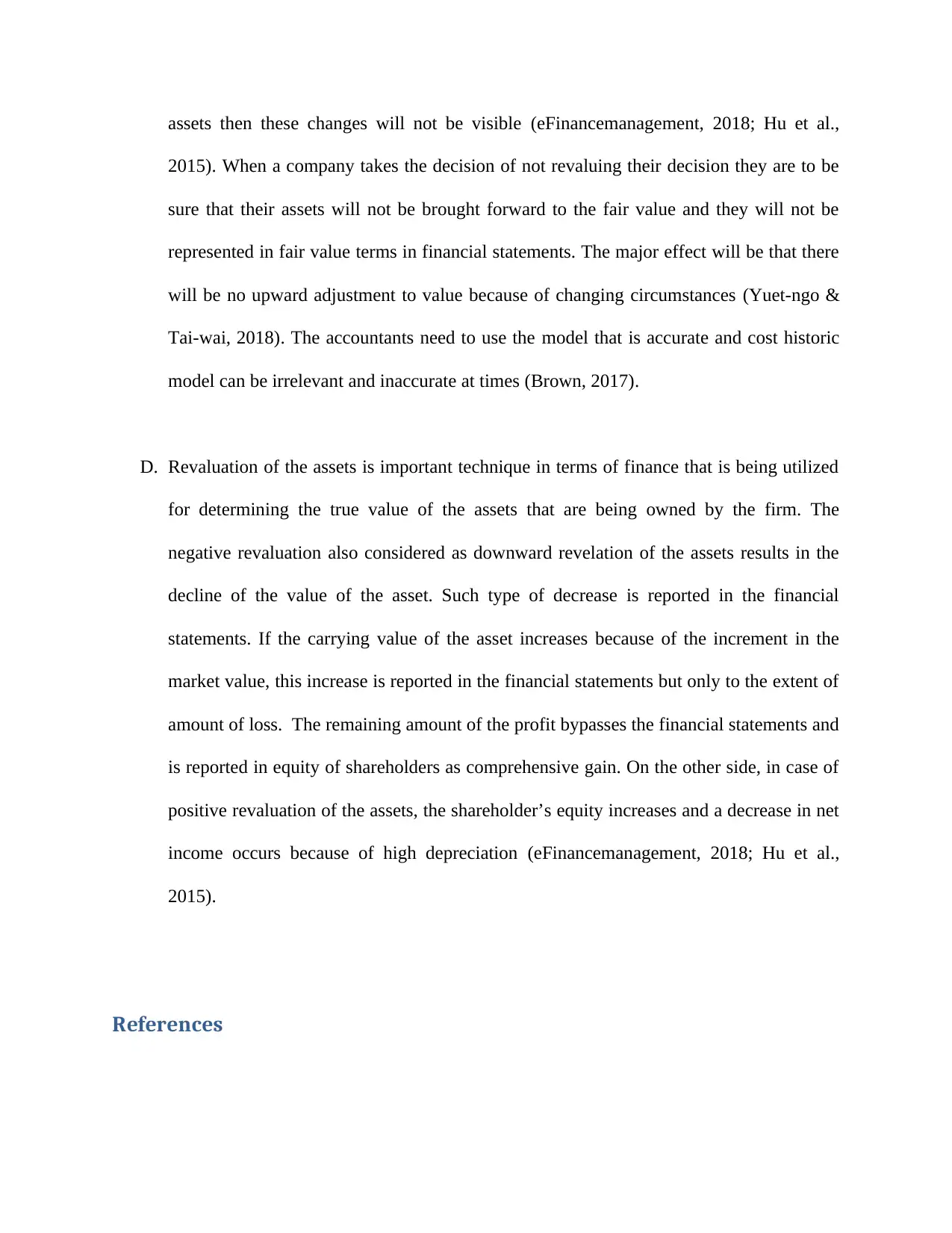
assets then these changes will not be visible (eFinancemanagement, 2018; Hu et al.,
2015). When a company takes the decision of not revaluing their decision they are to be
sure that their assets will not be brought forward to the fair value and they will not be
represented in fair value terms in financial statements. The major effect will be that there
will be no upward adjustment to value because of changing circumstances (Yuet-ngo &
Tai-wai, 2018). The accountants need to use the model that is accurate and cost historic
model can be irrelevant and inaccurate at times (Brown, 2017).
D. Revaluation of the assets is important technique in terms of finance that is being utilized
for determining the true value of the assets that are being owned by the firm. The
negative revaluation also considered as downward revelation of the assets results in the
decline of the value of the asset. Such type of decrease is reported in the financial
statements. If the carrying value of the asset increases because of the increment in the
market value, this increase is reported in the financial statements but only to the extent of
amount of loss. The remaining amount of the profit bypasses the financial statements and
is reported in equity of shareholders as comprehensive gain. On the other side, in case of
positive revaluation of the assets, the shareholder’s equity increases and a decrease in net
income occurs because of high depreciation (eFinancemanagement, 2018; Hu et al.,
2015).
References
2015). When a company takes the decision of not revaluing their decision they are to be
sure that their assets will not be brought forward to the fair value and they will not be
represented in fair value terms in financial statements. The major effect will be that there
will be no upward adjustment to value because of changing circumstances (Yuet-ngo &
Tai-wai, 2018). The accountants need to use the model that is accurate and cost historic
model can be irrelevant and inaccurate at times (Brown, 2017).
D. Revaluation of the assets is important technique in terms of finance that is being utilized
for determining the true value of the assets that are being owned by the firm. The
negative revaluation also considered as downward revelation of the assets results in the
decline of the value of the asset. Such type of decrease is reported in the financial
statements. If the carrying value of the asset increases because of the increment in the
market value, this increase is reported in the financial statements but only to the extent of
amount of loss. The remaining amount of the profit bypasses the financial statements and
is reported in equity of shareholders as comprehensive gain. On the other side, in case of
positive revaluation of the assets, the shareholder’s equity increases and a decrease in net
income occurs because of high depreciation (eFinancemanagement, 2018; Hu et al.,
2015).
References
⊘ This is a preview!⊘
Do you want full access?
Subscribe today to unlock all pages.

Trusted by 1+ million students worldwide
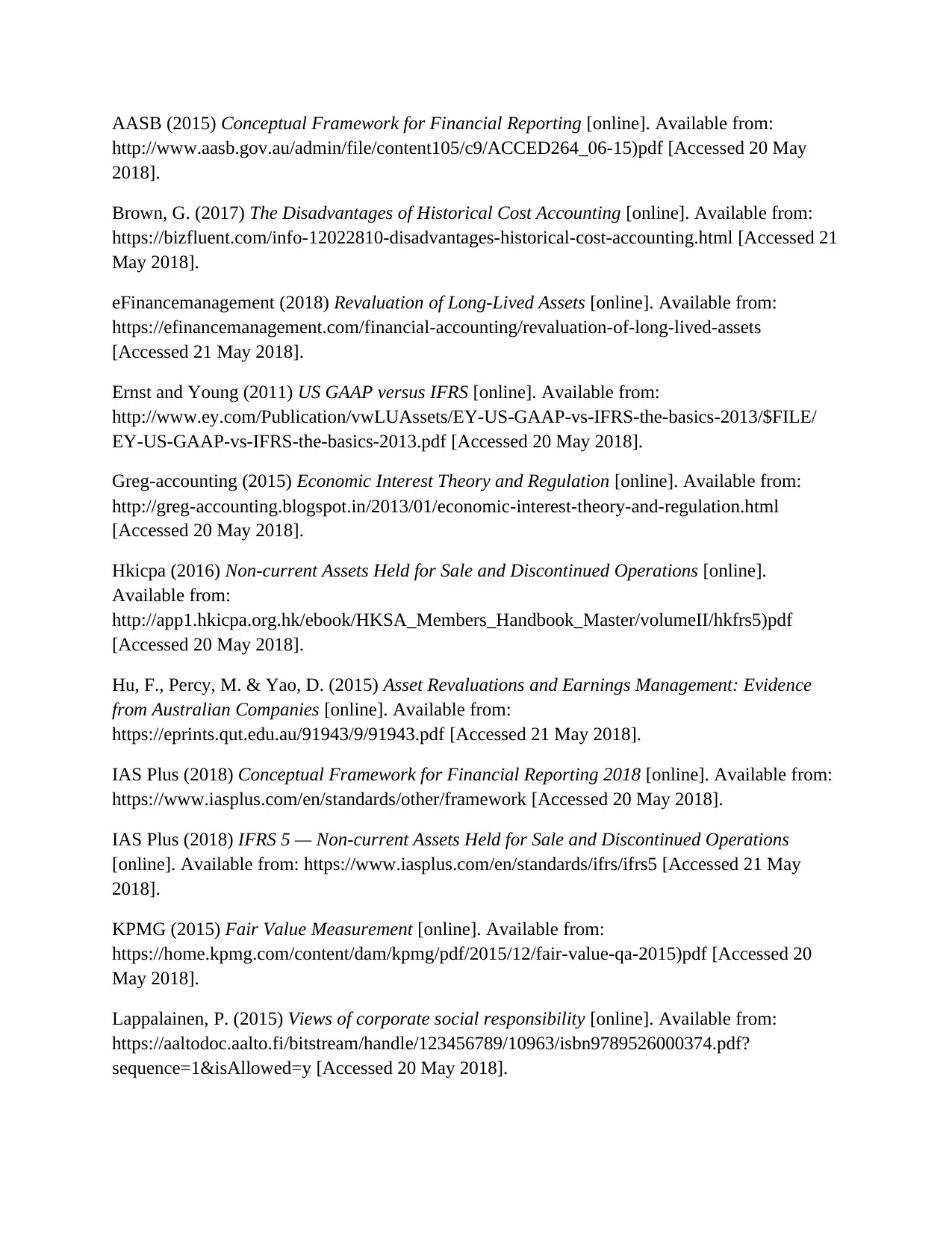
AASB (2015) Conceptual Framework for Financial Reporting [online]. Available from:
http://www.aasb.gov.au/admin/file/content105/c9/ACCED264_06-15)pdf [Accessed 20 May
2018].
Brown, G. (2017) The Disadvantages of Historical Cost Accounting [online]. Available from:
https://bizfluent.com/info-12022810-disadvantages-historical-cost-accounting.html [Accessed 21
May 2018].
eFinancemanagement (2018) Revaluation of Long-Lived Assets [online]. Available from:
https://efinancemanagement.com/financial-accounting/revaluation-of-long-lived-assets
[Accessed 21 May 2018].
Ernst and Young (2011) US GAAP versus IFRS [online]. Available from:
http://www.ey.com/Publication/vwLUAssets/EY-US-GAAP-vs-IFRS-the-basics-2013/$FILE/
EY-US-GAAP-vs-IFRS-the-basics-2013.pdf [Accessed 20 May 2018].
Greg-accounting (2015) Economic Interest Theory and Regulation [online]. Available from:
http://greg-accounting.blogspot.in/2013/01/economic-interest-theory-and-regulation.html
[Accessed 20 May 2018].
Hkicpa (2016) Non-current Assets Held for Sale and Discontinued Operations [online].
Available from:
http://app1.hkicpa.org.hk/ebook/HKSA_Members_Handbook_Master/volumeII/hkfrs5)pdf
[Accessed 20 May 2018].
Hu, F., Percy, M. & Yao, D. (2015) Asset Revaluations and Earnings Management: Evidence
from Australian Companies [online]. Available from:
https://eprints.qut.edu.au/91943/9/91943.pdf [Accessed 21 May 2018].
IAS Plus (2018) Conceptual Framework for Financial Reporting 2018 [online]. Available from:
https://www.iasplus.com/en/standards/other/framework [Accessed 20 May 2018].
IAS Plus (2018) IFRS 5 — Non-current Assets Held for Sale and Discontinued Operations
[online]. Available from: https://www.iasplus.com/en/standards/ifrs/ifrs5 [Accessed 21 May
2018].
KPMG (2015) Fair Value Measurement [online]. Available from:
https://home.kpmg.com/content/dam/kpmg/pdf/2015/12/fair-value-qa-2015)pdf [Accessed 20
May 2018].
Lappalainen, P. (2015) Views of corporate social responsibility [online]. Available from:
https://aaltodoc.aalto.fi/bitstream/handle/123456789/10963/isbn9789526000374.pdf?
sequence=1&isAllowed=y [Accessed 20 May 2018].
http://www.aasb.gov.au/admin/file/content105/c9/ACCED264_06-15)pdf [Accessed 20 May
2018].
Brown, G. (2017) The Disadvantages of Historical Cost Accounting [online]. Available from:
https://bizfluent.com/info-12022810-disadvantages-historical-cost-accounting.html [Accessed 21
May 2018].
eFinancemanagement (2018) Revaluation of Long-Lived Assets [online]. Available from:
https://efinancemanagement.com/financial-accounting/revaluation-of-long-lived-assets
[Accessed 21 May 2018].
Ernst and Young (2011) US GAAP versus IFRS [online]. Available from:
http://www.ey.com/Publication/vwLUAssets/EY-US-GAAP-vs-IFRS-the-basics-2013/$FILE/
EY-US-GAAP-vs-IFRS-the-basics-2013.pdf [Accessed 20 May 2018].
Greg-accounting (2015) Economic Interest Theory and Regulation [online]. Available from:
http://greg-accounting.blogspot.in/2013/01/economic-interest-theory-and-regulation.html
[Accessed 20 May 2018].
Hkicpa (2016) Non-current Assets Held for Sale and Discontinued Operations [online].
Available from:
http://app1.hkicpa.org.hk/ebook/HKSA_Members_Handbook_Master/volumeII/hkfrs5)pdf
[Accessed 20 May 2018].
Hu, F., Percy, M. & Yao, D. (2015) Asset Revaluations and Earnings Management: Evidence
from Australian Companies [online]. Available from:
https://eprints.qut.edu.au/91943/9/91943.pdf [Accessed 21 May 2018].
IAS Plus (2018) Conceptual Framework for Financial Reporting 2018 [online]. Available from:
https://www.iasplus.com/en/standards/other/framework [Accessed 20 May 2018].
IAS Plus (2018) IFRS 5 — Non-current Assets Held for Sale and Discontinued Operations
[online]. Available from: https://www.iasplus.com/en/standards/ifrs/ifrs5 [Accessed 21 May
2018].
KPMG (2015) Fair Value Measurement [online]. Available from:
https://home.kpmg.com/content/dam/kpmg/pdf/2015/12/fair-value-qa-2015)pdf [Accessed 20
May 2018].
Lappalainen, P. (2015) Views of corporate social responsibility [online]. Available from:
https://aaltodoc.aalto.fi/bitstream/handle/123456789/10963/isbn9789526000374.pdf?
sequence=1&isAllowed=y [Accessed 20 May 2018].
Paraphrase This Document
Need a fresh take? Get an instant paraphrase of this document with our AI Paraphraser
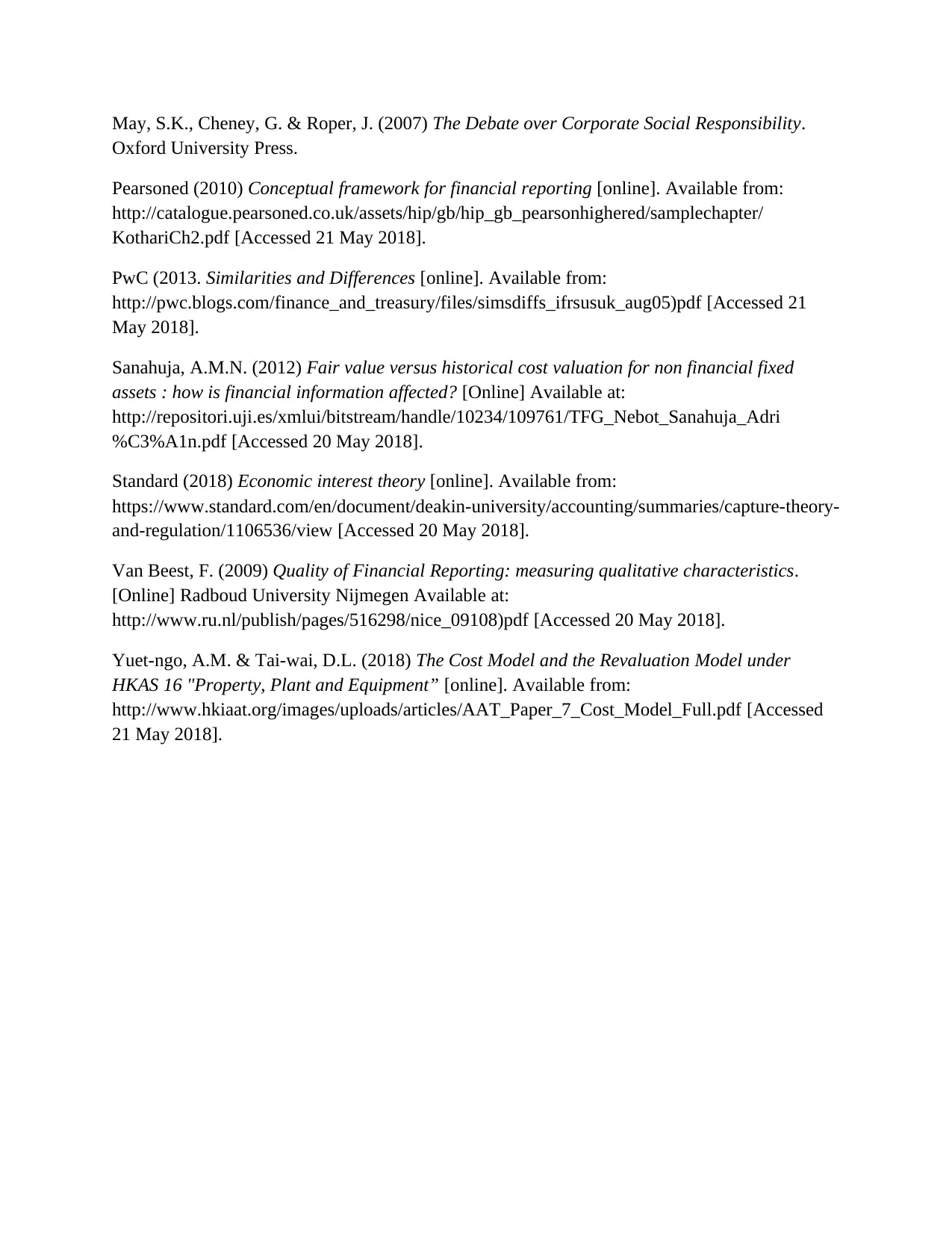
May, S.K., Cheney, G. & Roper, J. (2007) The Debate over Corporate Social Responsibility.
Oxford University Press.
Pearsoned (2010) Conceptual framework for financial reporting [online]. Available from:
http://catalogue.pearsoned.co.uk/assets/hip/gb/hip_gb_pearsonhighered/samplechapter/
KothariCh2.pdf [Accessed 21 May 2018].
PwC (2013. Similarities and Differences [online]. Available from:
http://pwc.blogs.com/finance_and_treasury/files/simsdiffs_ifrsusuk_aug05)pdf [Accessed 21
May 2018].
Sanahuja, A.M.N. (2012) Fair value versus historical cost valuation for non financial fixed
assets : how is financial information affected? [Online] Available at:
http://repositori.uji.es/xmlui/bitstream/handle/10234/109761/TFG_Nebot_Sanahuja_Adri
%C3%A1n.pdf [Accessed 20 May 2018].
Standard (2018) Economic interest theory [online]. Available from:
https://www.standard.com/en/document/deakin-university/accounting/summaries/capture-theory-
and-regulation/1106536/view [Accessed 20 May 2018].
Van Beest, F. (2009) Quality of Financial Reporting: measuring qualitative characteristics.
[Online] Radboud University Nijmegen Available at:
http://www.ru.nl/publish/pages/516298/nice_09108)pdf [Accessed 20 May 2018].
Yuet-ngo, A.M. & Tai-wai, D.L. (2018) The Cost Model and the Revaluation Model under
HKAS 16 "Property, Plant and Equipment” [online]. Available from:
http://www.hkiaat.org/images/uploads/articles/AAT_Paper_7_Cost_Model_Full.pdf [Accessed
21 May 2018].
Oxford University Press.
Pearsoned (2010) Conceptual framework for financial reporting [online]. Available from:
http://catalogue.pearsoned.co.uk/assets/hip/gb/hip_gb_pearsonhighered/samplechapter/
KothariCh2.pdf [Accessed 21 May 2018].
PwC (2013. Similarities and Differences [online]. Available from:
http://pwc.blogs.com/finance_and_treasury/files/simsdiffs_ifrsusuk_aug05)pdf [Accessed 21
May 2018].
Sanahuja, A.M.N. (2012) Fair value versus historical cost valuation for non financial fixed
assets : how is financial information affected? [Online] Available at:
http://repositori.uji.es/xmlui/bitstream/handle/10234/109761/TFG_Nebot_Sanahuja_Adri
%C3%A1n.pdf [Accessed 20 May 2018].
Standard (2018) Economic interest theory [online]. Available from:
https://www.standard.com/en/document/deakin-university/accounting/summaries/capture-theory-
and-regulation/1106536/view [Accessed 20 May 2018].
Van Beest, F. (2009) Quality of Financial Reporting: measuring qualitative characteristics.
[Online] Radboud University Nijmegen Available at:
http://www.ru.nl/publish/pages/516298/nice_09108)pdf [Accessed 20 May 2018].
Yuet-ngo, A.M. & Tai-wai, D.L. (2018) The Cost Model and the Revaluation Model under
HKAS 16 "Property, Plant and Equipment” [online]. Available from:
http://www.hkiaat.org/images/uploads/articles/AAT_Paper_7_Cost_Model_Full.pdf [Accessed
21 May 2018].
1 out of 11
Related Documents
Your All-in-One AI-Powered Toolkit for Academic Success.
+13062052269
info@desklib.com
Available 24*7 on WhatsApp / Email
![[object Object]](/_next/static/media/star-bottom.7253800d.svg)
Unlock your academic potential
Copyright © 2020–2025 A2Z Services. All Rights Reserved. Developed and managed by ZUCOL.




